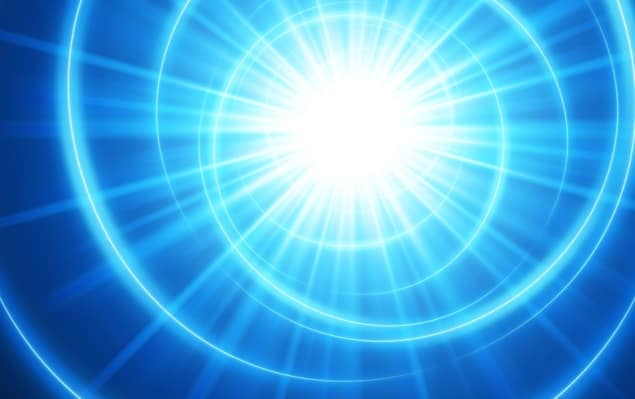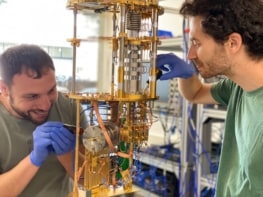
Physicists in Spain and the US have shown that the orbital angular momentum, or twistedness, of light can be made to vary rapidly in time. The researchers demonstrated what they call “self-torque” by generating high-frequency harmonics from two intense infrared laser pulses offset very slightly in time. They argue that light with this property could in future provide an ideal tool for manipulating molecules and other nanometre-sized structures.
Spin angular momentum is a familiar property of light, being manifest in the polarization of the light. But since 1992 it has been known that light exhibits a distinct property known as orbital angular momentum (OAM). This results in a twisting of a beam’s wavefront around its propagation axis so that the light takes on a spiral shape with zero intensity at its core. A beam can in principle have any amount of twistedness, with greater twist meaning that the wavefront rotates more quickly.
Physicists are using OAM to develop a range of new technologies. The number of data channels in a fibre-optic cable can be boosted by sending down light with multiple values of OAM, just as it can be enhanced via greater frequency bandwidth. Beams with OAM can also increase the resolution of microscopy and be used to manipulate microscopic objects such as nanoparticles, quantum dots and even living cells.
Twist in time
However, until now all light beams have a had a constant twist. In the latest work, scientists at the University of Salamanca and the Institute of Photonic Sciences (ICFO) in Barcelona working with colleagues at JILA in Colorado have shown it is possible to vary the twist in time – either speeding up or slowing down the rotation of the wavefront – by creating a light pulse from high-frequency harmonics. The “self-torque” generates this variation in momentum.
“With mechanical systems you need external forces,” says Salamanca team leader Carlos Hernández-García. “But in these light beams we have the torque without the presence of external forces.”
High-frequency harmonics can be created by firing intense infrared laser pulses into a gas. This ionizes the gas and free electrons stimulate ultraviolet emissions from the gas after being accelerated by the laser’s strong electric field. The emissions occur over a wide range of harmonics, resulting in light with frequencies hundreds or even thousands of times higher than that of the laser pulses.
Topological charge
Drawing up new models of harmonic generation, Hernández-García, Laura Rego and colleagues in Salamanca realized it should be possible to use this technique to generate self-torque. What was needed, they reasoned, were two infrared pulses with different amounts of OAM (or different values of their topological charge l) separated by a very short time interval. They reckoned that by superimposing these pulses and passing them through a gas, the l values of the resulting harmonics should vary in time.
The scheme relies on the fact that high-frequency harmonics of pulses with OAM will have proportionally higher l values than the pulses themselves (given that higher frequencies force the wavefront to twist more quickly). Because the 17th harmonic, say, of an l=1 and l=2 pulse will have l values of 17 and 34 respectively, that harmonic will have its l value vary stepwise from 17 to 34 when an l=1 pulse is merged with a trailing (and as such partially overlapping) l=2 pulse.
“As the ratio between the two pulses changes in time,” explains Hernández-García, “the OAM value of the harmonic, following conservation of momentum, also changes in time”.
These ideas were then realized in the lab by Kevin Dorney and colleagues at JILA, who focused superimposed l=1 and l=2 infrared pulses, each only around 50 fs long, on to a jet of argon. One of the biggest experimental challenges was being able to observe the effects of the self-torque, given that no available technique can resolve variations in OAM over femtosecond timescales. To do that they looked for, and found, a tell-tale sign in the spatial profile of the ultraviolet laser pulse that had been predicted by the Salamanca group – a continuous change in frequency, or “chirp”, across the doughnut-shaped profile.
Excellent agreement
“The agreement with our theoretical predictions was really excellent, and that allowed us to say that the beams were generated with self-torque,” says Hernández-García.

Doughnut waveguide preserves twisted light
As to how the work could be applied practically, Hernández-García is reluctant to say too much – stating only that it might benefit applications that “require the ultrafast recording of information”. But Dorney is more specific, suggesting the research might enhance studies of “chiral molecules at the nanoscale” or improve understanding of the processes taking place inside the materials used to make smart phones and hard drives.
Ben McMorran of the University of Oregon praises the researchers for their “mastery of several advanced technologies in optics”, reckoning that their work could help “control and probe the movements and orientations of electrons in materials”. But he questions the term “self-torque”, arguing that the laser pulses do not themselves generate torque but instead pass it on. “Think of these pulses not as a motor but a driveshaft,” he says.
The research is described in Science.



